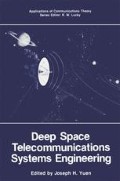Abstract
This chapter presents an introductory discussion of the receivers used in deep space communications. The basic structures, principles of operations, and characteristics of these receivers are examined to provide an understanding of the important parameters in the design and performance evaluation.
Access this chapter
Tax calculation will be finalised at checkout
Purchases are for personal use only
Preview
Unable to display preview. Download preview PDF.
References
Jaffe, R. M., and Rechtin, E., “Design and Performance of Phase-Lock Circuits Capable of Near Optimum Performance Over a Wide Range of Input Signals and Noise Levels,” IRE Transactions on Information Theory, Vol. IT-1, pp. 66–76, Mar. 1955.
Viterbi, A. J., Principles of Coherent Communications, McGraw-Hill, New York, 1966.
Lindsey, W. C., Synchronization Systems in Communication and Control, Prentice-Hall, Englewood Cliffs, N.J., 1972.
Blanchard, A., Phase Locked Loops: Application to Coherent Receiver Design, Interscience, New York, 1976.
Tausworth, R. C., Theory and Practical Design of Phase-Locked Receivers, Volume 1, Report No. 32–819, Jet Propulsion Laboratory, Pasadena, C.lif., Feb. 16, 1966.
Lindsey, W. C., and Simon, M. K., Telecommunication Systems Engineering, Prentice-Hall, Englewood Cliffs, N.J., 1973.
Lindsey, W. C., and Simon, M. K., editors, Phase-Locked Loops and Their Application, IEEE Press, New York, 1978.
Gardner, F. M., Phaselock Techniques, John Wiley and Sons, New York, 1979.
Holliday, D., “A Review of Some Phase-Locked Loop Theory,” Proceedings, International Communication Conference, Montreal, Canada, pp. 3–2 to 3–8, June 1971.
Lindsey, W. C., “Coding and Synchronization Studies: Moments of the First Passage Time in Generalized Tracking Systems,” Space Program Summary 37–58, Vol. III, pp. 63–66, Jet Propulsion Laboratory, Pasadena, C.lif., Aug. 31, 1969.
Frazier, J. P., and Page, J, J., “Phase-Lock Loop Frequency Acquisition Study,” Transactions of the IRE, Vol. SET-8, Sept. 1962.
Tikhonov, V. I., “The Effect of Noise on Phase-Locked Oscillator Operation,” Automation and Remote Control, Vol. 20, (1959) 1160–1168. Translated from Automatika i Telemekhaniki, Akademya Nauk SSSR, Vol. 20, Sept. 1959.
Tikhonov, V. L, “Phase-Lock Automatic Frequency Control Operation in the Presence of Noise,” Automation and Remote Control, Vol. 21, (1960) 209–214. Translated from Automatika i Telemekhaniki, Akademya Nauk SSSR, Vol. 21, Mar. 1960.
Viterbi, A. J., “Phase-Locked Loop Dynamics in the Presence of Noise by Fokker-Planck Techniques,” Proceedings of the IEEE, Vol. 51, No. 12, pp. 1737–1753, Dec. 1963.
Charles, F. J., and Lindsey, W. C., “Some Analytical and Experimental Phase-Locked Loop Results for Low Signal-to-Noise Ratios,” IEEE Proceedings, Vol. 54, No. 9, pp. 1152–1166, Sept. 1966.
Tausworth, R., and Sanger, D., “Digital Communication and Tracking: Experimental Study of the First Slip Statistics of the Second Order Phase Locked Loop,” Space Programs Summary 37–43, Vol. III, pp. 76–80, Jet Propulsion Laboratory, Pasadena, Calif., Jan. 31, 1967.
Yuen, J. H., “On First Cycle Slip Time of Phase Locked Loops in Cascade,” IEEE Transactions on Aerospace and Electronics Systems, Vol. AES-10, No. 3, pp. 373–379, May 1974.
Davenport, W. B., “Signal-to-Noise Ratios in Band-Pass Limiters,” Journal of Applied Physics, 24, pp. 720–727, June 1953.
Springett, J. C., and Simon, M. K., “An Analysis of the Phase Coherent-Incoherent Output of the Bandpass Limiter,” IEEE Transactions on Communication Technology, Vol. COM-19, No. 1, pp. 42–49, Feb. 1971.
Tausworthe, R. C., “Information Processing: Limiters in Phase-Locked Loops: A Correction to Previous Theory,” Space Programs Summary 37–54, Vol. III, pp. 201–204, Jet Propulsion Laboratory, Pasadena, C.lif., Dec. 31, 1968.
Lesh, J., “Tracking Loop and Modulation Format Considerations for High Rate Telemetry,” DSN Progress Report 42–44, J.t Propulsion Laboratory, Pasadena, Calif., pp. 117–124, Apr. 15, 1978.
Reasoner, R., Stevens, G., and Woo, K. T., “Costas Loop Demodulation of Suppressed Carrier BPSK in the DSN Environment-Experimental Results Obtained at TDL,” DSN Progress Report 42–51, Jet Propulsion Laboratory, Pasadena, Calif., pp. 94–104, June 15, 1979.
Woo, K. T., “Effects of Asymmetric Passband Filtering on the Phase of the Costas Loop’s Reconstructed Carrier,” DSN Progress Report 42–51, Jet Propulsion Laboratory, Pasadena, Calif., pp. 105–112, June 15, 1979.
Stevens, G., and Woo, K. T., “Design of Costas Loop to Operate with the Block III Receiver and Its Predicted Performance,” DSN Progress Report 42–51, Jet Propulsion Laboratory, Pasadena, Calif., pp. 113–123, June 15, 1979.
Simon, M. K., and Lindsey, W. C., “Optimum Performance of Suppressed Carrier Receivers with Costas Loop Tracking,” IEEE Transactions on Communications, Vol. COM-25, No. 2, pp. 215–227, Feb. 1977.
Simon, M. K., “On the Calculation of Squaring Loss in Costas Loops with Arbitrary Arm Filters,” IEEE Transactions on Communications, Vol. COM-26, No. 1, pp. 179–184, Jan. 1978.
Simon, M. K., “Tracking Performance of Costas Loops with Hard-Limited In-Phase Channel,” IEEE Transactions on Communications, Vol. COM-26, No. 4, pp. 420–432, Apr. 1978.
Brockman, M. H., “MMTS Subcarrier Demodulator,” Space Programs Summary 37–46, Vol. III, Jet Propulsion Laboratory, Pasadena, Calif., pp. 189–204, July 31, 1967.
Simon, M. K., and Alem, W. K., “Tracking Performance of Unbalanced QPSK Demodulators; Part I—Biphase Costas Loop with Passive Arm Filters,” IEEE Transactions on Communications, Vol. COM-26, No. 8, pp. 1147–1156, Aug. 1978.
-30. Simon, M. K., “Tracking Performance of Unbalanced QPSK Demodulators; Part II—Biphase Costas Loop with Active Arm Filters,” IEEE Transactions on Communications, Vol. COM-26, No. 8, pp. 1157–1166, Aug. 1978.
Victor, W. K., and Brockman, M. H., “The Application of Linear Servo Theory to the Design of AGC Loops,” Proceedings of the IRE, Vol. 48, pp. 234–238, Feb. 1960.
Ohlson, J. E., “Exact Dynamics of Automatic Gain Control,” IEEE Transactions on Communications, Vol. COM-22, pp. 72–74, Jan. 1974.
Weber, W. J., III, “Decision-Directed Automatic Gain Control for MAPSK Systems,” IEEE Transactions on Communications, Vol. COM-23, No. 5, pp. 510–517, May 1975.
Kemeny, J., and Snell, J., Finite Markov Chains, Van Nostrand, N.Y., 1960.
Editor information
Editors and Affiliations
Rights and permissions
Copyright information
© 1983 Springer Science+Business Media New York
About this chapter
Cite this chapter
Simon, M.K., Yuen, J.H. (1983). Receiver Design and Performance Characteristics. In: Yuen, J.H. (eds) Deep Space Telecommunications Systems Engineering. Applications of Communications Theory. Springer, Boston, MA. https://doi.org/10.1007/978-1-4757-4923-6_3
Download citation
DOI: https://doi.org/10.1007/978-1-4757-4923-6_3
Publisher Name: Springer, Boston, MA
Print ISBN: 978-1-4757-4925-0
Online ISBN: 978-1-4757-4923-6
eBook Packages: Springer Book Archive

